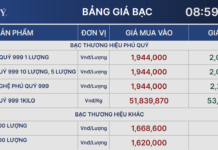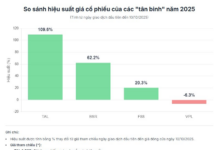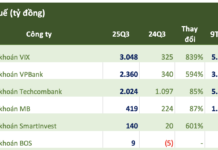
Executive Vice President and CEO of Saigon Thuong Tin Commercial Joint Stock Bank (Sacombank), Nguyen Duc Thach Diem – Photo: VGP/Nhat Bac |
Credit growth has yet to meet expectations
At the conference held by the Government’s Standing Committee with joint-stock commercial banks on the afternoon of September 21st, Executive Vice President and CEO of Saigon Thuong Tin Commercial Joint Stock Bank (Sacombank), Nguyen Duc Thach Diem, shared that since the beginning of the year, Sacombank has closely followed the Government’s and SBV’s directives to develop policies and internal orientations to promote safe and effective credit growth.
As a result, by August 31st, the bank’s business lending reached VND347,000 billion, an increase of nearly VND25,000 billion, accounting for 67% of the additional outstanding balance. Lending to five priority sectors reached nearly VND165,000 billion, an increase of VND15,000 billion compared to the beginning of the year. Lending to the real estate sector reached VND104,000 billion, an increase of VND9,000 billion, or 9.8%, of which nearly 50% of the outstanding balance was for real estate consumption lending. Consumer lending exceeded VND57,000 billion, an increase of over VND3,000 billion, or 6.2%.
According to Ms. Nguyen Duc Thach Diem, Sacombank has implemented several solutions to promote safe and effective credit growth. These include closely managing capital costs, reducing deposit interest rates by 1.2% since the beginning of the year, thereby facilitating a nearly 1.5% reduction in lending rates. As a result, Sacombank has sacrificed a portion of its profits to share difficulties with customers. In reality, the disbursement interest rate at Sacombank is currently around 7.5%/year (with individual customers at 7.9% and enterprises at 7%).
The bank has deployed VND100,000 billion in preferential loan packages with interest rates ranging from 3% to 6.5%, with a disbursement turnover of VND130,000 billion, supporting more than 33,000 customers. Regarding the preferential credit program for the forestry and aquatic industries with a limit of VND3,000 billion, Sacombank has disbursed to 2,053 customers with a turnover of VND4,168 billion.
Regarding the reasons and difficulties leading to slow credit growth, according to Sacombank’s leader, although many solutions and mechanisms have been applied to promote growth, credit growth in the industry, in general, and Sacombank, in particular, has yet to meet expectations due to certain challenges. These include: Capital demand remains low as exports and domestic consumption have not recovered. Many businesses are scaling down production and are cautious about risks, so they are hesitant to use loans.
In addition, the income of real estate buyers has decreased, while the supply of affordable housing to meet living needs has not been met. Real estate companies/projects are still facing difficulties due to incomplete legal procedures and a severe decline in financial capacity.
Apart from the decline in people’s income due to economic difficulties, the proliferation of lending apps with relaxed lending conditions and no collateral requirements has also divided the market share of consumer credit, resulting in slow growth.
Maintain an expansionary fiscal policy to stimulate aggregate demand
At the conference, Ms. Nguyen Duc Thach Diem, CEO of Sacombank, proposed several solutions and recommendations to promote credit growth.
As a solution, it is necessary to continue reducing capital costs and lowering the lending interest rate to enhance capital accessibility. Deploy preferential credit packages for certain sectors and industries as directed by the Government and the SBV.
Continue to coordinate with industry associations (such as the Real Estate Association, Cashew Association, Coffee Association, and Macadamia Association) to implement preferential mechanisms regarding products and interest rates to help customers access affordable capital and increase outstanding loans.
Enhance measures to improve risk management effectiveness to control credit risk in line with credit growth targets.
Streamline internal procedures and regulations for credit issuance; Apply technology to products and services to reduce transaction time, enhance customer experience, and increase transaction safety.
The CEO of Sacombank suggested maintaining an expansionary fiscal policy to stimulate aggregate demand and promote growth. Implement tax and fee reduction measures to directly support consumption demand and increase economic purchasing power.
In addition, there should be communication from the State to create a sense of assurance, necessity, and promotion of the safety and convenience of digital transaction channels to encourage all citizens to embrace them.
Moreover, payment intermediaries should consider reducing fees to join hands with commercial banks in waiving fees for users.
Finally, it is necessary to improve the legal system related to secured asset handling under the Law on Credit Institutions of 2024 (promulgating decrees and circulars for guidance and considering alternative measures to seize secured assets). At the same time, provide more detailed guidance on initiating lawsuits regarding unsecured consumer lending through apps.
“Caution Advised: VIB Chairman Đặng Khắc Vỹ Cautions Against Loosening Credit Conditions for Short-Term Growth”
“VIB’s Board Chairman, Dang Khac Vy, cautioned against pursuing credit growth at all costs by relaxing lending conditions. He emphasized the potential adverse consequences on the safety and stability of the banking sector, citing increased non-performing loans and diminished profits as key concerns.”
“Unveiling the True Extent of Non-Performing Loans in Private Banks: A Critical Analysis”
“There are some standout figures in the recently released SBV report on the private banking sector: average lending rates, foreign exchange transactions, credit growth, profits, non-performing loans, CAR, and more. These metrics paint a detailed picture of the industry’s health and performance.”
Sure, I can assist with that.
## Empowering Borrowers and Unraveling the Complexities of Collateral: A Lender’s Perspective
“In a proposal to the government, the Chairman of TPBank emphasized the need for enhanced public awareness and borrower accountability regarding loan debts. The bank seeks to address the challenging situation where lenders find themselves ‘standing when granting loans but kneeling when collecting debts.’ This metaphor highlights the urgent requirement for a cultural shift in borrowing behavior and a more responsible attitude toward financial obligations.”







































